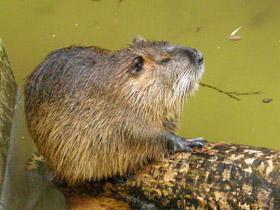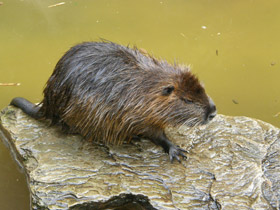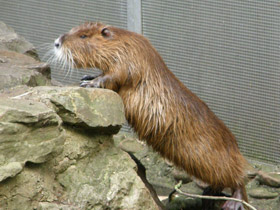The nutria or coypu (Myocastor coypus)
The nutria or coypu (Myocastor coypus) is a large, herbivorous, semiaquatic rodent from South America. Classified for a long time as the only member of the family Myocastoridae, Myocastor is now included within Echimyidae, the family of the spiny rats. The nutria lives in burrows alongside stretches of water and feeds on river plant stems. Originally native to subtropical and temperate South America, it has since been introduced to North America, Europe, Asia, and Africa, primarily by fur farmers. Although it is still hunted and trapped for its fur in some regions, its destructive burrowing and feeding habits often bring it into conflict with humans, and it is considered an invasive species in the United States. Nutria also transmit various diseases to humans and animals, mainly through water contamination.
Appearance
Externally, this rodent resembles a large rat: its body length is up to 60 cm, tail length up to 45 cm, weight 5-10 kg. The body of Myocastor coypus is heavy; the head is massive, with disproportionately small eyes and ears; the limbs are relatively short; the muzzle is blunt, with long vibrissae and bright orange incisors. Myocastor coypus leads a semi-aquatic lifestyle, and so it has a number of anatomical features associated with this. For example, its nasal openings have special locking muscles and can close tightly. The lips of this rodent are separated in front and close tightly behind the incisors, which allows Myocastor coypus to chew off plants underwater without allowing water to enter its mouth. Between the toes of the hind limbs (except the outer one) in Myocastor coypus have webs; they are almost hairless and covered with scaly skin; when swimming, it serves as a rudder. Mammary glands and nipples (4-5 pairs) are located in females high on the sides, which allows the cubs to feed while in the water. The fur of Myocastor coypus is waterproof and consists of a long coarse awn and a dense brownish-coloured curved undercoat. The fur is thicker on the abdomen and flanks than on the back, which favours heat retention in the lower part of the body.
Etymology
The genus name Myocastor derives from the two Ancient Greek words μῦς (mûs) 'rat, mouse', and κάστωρ (kástōr) 'beaver'. Literally, therefore, the name Myocastor means 'mouse beaver'.
Two names are commonly used in English for Myocastor coypus. The name nutria (from the Spanish word nutria 'otter') is generally used in North America, Asia, and throughout countries of the former Soviet Union; however, in most Spanish-speaking countries, the word nutria refers primarily to the otter. To avoid this ambiguity, the name coypu or coipo (derived from Mapudungun) is used in South America, Britain and other parts of Europe. In France, the nutria is known as a ragondin. In Dutch, it is known as beverrat 'beaver rat'. In German, it is known as Nutria, Biberratte 'beaver rat', or Sumpfbiber 'swamp beaver'. In Italy, instead, the popular name is, as in North America and Asia, nutria, but it is also called castorino 'little beaver', by which its fur is known in Italy. In Swedish, the animal is known as sumpbäver 'marsh/swamp beaver'. In Brazil, the animal is known as ratão-do-banhado 'big swamp rat', nútria, or caxingui (the last from Tupi).
Taxonomy
The nutria was first described by Juan Ignacio Molina in 1782 as Mus coypus, a member of the mouse genus.The genus Myocastor was assigned in 1792 by Robert Kerr. Geoffroy Saint-Hilaire, independently of Kerr, named the species Myopotamus coypus, and it is occasionally referred to by this name.
Four subspecies are generally recognized:
- Myocastor coypus bonariensis: northern Argentina, Bolivia, Paraguay, Uruguay, southern Brazil (RS, SC, PR, and SP);
- Myocastor coypus coypus: central Chile, Bolivia;
- Myocastor coypus melanops: Chiloé Island;
- Myocastor coypus santacruzae: Patagonia.
Myocastor coypus bonariensis, the subspecies present in the northernmost (subtropical) part of the nutria's range, is believed to be the type of nutria most commonly introduced to other continents.
Where Myocastor coypus lives, habitat
The natural range of Myocastor coypus is limited to the southern half of South America from Bolivia and southern Brazil to Tierra del Fuego. The favourite habitats of this animal are water bodies with low-flowing or standing water: marshy riverbanks, reed-horn lakes and alder and sedge swamps with rich aquatic and riparian vegetation. Myocastor coypus avoids solid forests and does not ascend to mountains (Andes) above 1200 m above sea level. In the Chonos Archipelago (Chile) this rodent lives along the shores of salty and brackish water bodies. In natural conditions Myocastor coypus is active mainly at night. It feeds on rhizomes, stems and leaves of reeds and cattails. Additional food consists of reeds, water hazel, water lilies, and rdestas. Myocastor coypus rarely eats animal food (leeches, mollusks), if there is a lack of plant food. Myocastor coypus perfectly swims and dives, under water it can be up to 10 minutes. But this rodent is not adapted to living in freezing water bodies, although it can tolerate frosts up to -35°C. The point is that Myocastor coypus does not build a reliable shelter from cold and predators and does not store food for winter, as beaver, muskrat and other northern semi-aquatic rodents do. Under ice, it is poorly orientated, and diving into an ice hole, it may not find its way back out and perish.
Distribution
Native to subtropical and temperate South America, its range includes Chile, Argentina, Uruguay, Paraguay and the southern parts of Brazil and Bolivia. It has been introduced to North America, Europe, Asia, and Africa, primarily by fur ranchers. The distribution of nutrias outside South America tends to contract or expand with successive cold or mild winters. During cold winters, nutria often suffer frostbite on their tails, leading to infection or death. As a result, populations of nutria often contract and even become locally or regionally extinct as in the Scandinavian countries and such US states as Idaho, Montana, and Nebraska during the 1980s. During mild winters, their ranges tend to expand northward. For example, in recent years, range expansions have been noted in Washington and Oregon, as well as Delaware.
According to the U.S. Geological Survey, nutria were first introduced to the United States in California, in 1899. They were first brought to Louisiana in the early 1930s for the fur industry, and the population was kept in check, or at a small population size, because of trapping pressure from the fur traders. The earliest account of nutria spreading freely into Louisiana wetlands from their enclosures was in the early 1940s; a hurricane hit the Louisiana coast for which many people were unprepared, and the storm destroyed the enclosures, enabling the nutria to escape into the wild. According to the Louisiana Department of Wildlife and Fisheries, nutria were also transplanted from Port Arthur, Texas, to the Mississippi River in 1941 and then spread due to a hurricane later that year.
Lifestyle and behaviour of Myocastor coypus
Myocastor coypus has a well-developed sense of hearing - it becomes alert even at slight rustling. Despite its seeming clumsiness, it runs quite fast, making leaps and bounds, but it tires quickly. It rests and broods in open nests made on bumps and in dense thickets of bent reed and cattail stems. Myocastor coypus dig burrows in steep banks, from simple tunnels to complex systems of passages. Their shelters can be found along paths that the animal tramples in the surrounding vegetation. Myocastor coypus live in groups of 2-13 individuals, consisting of adult females, their offspring and a male. Young males usually live alone. Myocastor coypus is able to breed all year round, and is quite prolific. A single female can produce 2-3 litters per year, usually in spring and summer. This rodent is an object of trade and breeding in fur farms and on farms, and Myocastor coypus is bred not only for its standard brown colour, but also for its coloured ones - white, black, pink, beige, golden and others. Myocastor coypus are also bred for meat.
Myocastor coypus breeding
There are 6 known subspecies of Myocastor coypus, one of which, living in the subtropics, has been acclimatised in many countries of the world. The first farms for breeding Myocastor coypus were established in the late 19th and early 20th centuries in Argentina; later they were introduced to the USA, Europe and Asia. Myocastor coypus appeared in the USSR in 1930-1932, and from 1930 to 1963, 6270 animals were released in the southern regions of the Soviet Union. Acclimatisation was successful in Transcaucasia in the Lankaran area, in the Lower Kura basin in Georgia, and in southern Tajikistan. In some countries, wild Myocastor coypus are considered as pests destroying aquatic vegetation, damaging irrigation systems, dams and undermining river banks. However, Myocastor coypus is quickly domesticated and can be kept as a pet.
Herbiviory and habitat degradation
Nutria herbivory "severely reduces overall wetland biomass and can lead to the conversion of wetland to open water. "Unlike other common disturbances in marshlands, such as fire and tropical storms, which are a once- or few-times-a-year occurrence, nutria feed year round, so their effects on the marsh are constant. Also, nutria are typically more destructive in the winter than in the growing season, due largely to the scarcity of above-ground vegetation; as nutria search for food, they dig up root networks and rhizomes for food.
Pathogenic and viral reservoirs of zoonotic diseases
In addition to direct environmental damage, nutria are the host for a roundworm nematode parasite (Strongyloides myopotami) that can infect the skin of humans, causing dermatitis similar to strongyloidiasis. The condition is also called "nutria itch". Other parasites they can host are tapeworms, liver flukes, and blood flukes. Waterbody contamination by nutria occurs through urine and feces. Nutria also host fleas, ticks and chewing louse. They can carry several zoonotic diseases (diseases transmitted from animals to humans). They are reservoirs for salmonellosis, encephalomyocarditis virus, chlamydia psittaci and antibiotic resistant bacteria, Aeromonas spp. Other zoonotic disease of concern they are host reservoirs for are mycobacterium tuberculosis, septicemia, toxoplasmosis, and rickettsiosis. According to the CDC, nutria carry two out of eight diseases of concern for the United States, rabies and salmonellosis. Nutria are considered a global alien species and have potential to spread disease to livestock and humans. Nutria are found on every continent except Australia and Antarctica. Native to the southern hemisphere and spreading globally requires preventive monitoring for zoonotic disease transmission. Currently nutria immigration is monitored for habitat destruction of wetlands, farmlands, marshes and is measured in habitat loss in acres. Increased local awareness of viral, bacterial and parasitic transmission from nutria to humans and livestock will be of greater importance as climate change progresses.


















































